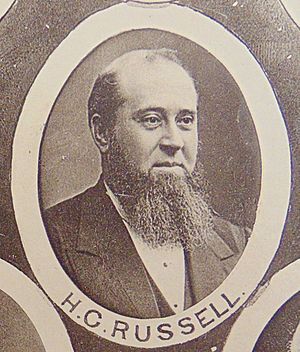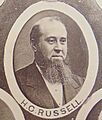Henry Chamberlain Russell facts for kids
Henry Chamberlain Russell (born March 17, 1836 – died February 22, 1907) was an important Australian astronomer and meteorologist. He studied stars and planets, and also focused on understanding the weather.
Contents
Early Life and Education
Henry Russell was born in West Maitland, New South Wales, Australia. He was the fourth son of Bourn Russell and Jane Mackreth. Henry went to school at West Maitland Grammar and later studied at the University of Sydney. He earned his Bachelor of Arts degree in 1859.
Working at Sydney Observatory
Russell started working at the Sydney Observatory, which is a place where scientists study the sky. He worked under William Scott. When Scott left, Russell became the temporary director. In 1870, he became the official government astronomer, a job he held for 35 years!
Russell quickly began to improve the observatory. He made it bigger and added new equipment. He even went on an expedition in 1871 to observe a total solar eclipse (when the Moon blocks the Sun).
One of his biggest projects was preparing for the transit of Venus in 1874. This is a rare event where Venus passes directly in front of the Sun. Russell set up four special stations and trained people to observe it. Their observations were very successful, and he later wrote a book about it.
Becoming a Weather Expert
Russell also became very interested in weather. In 1877, he published a big book called Climate of New South Wales, which described the weather patterns. He spent a lot of time studying if weather followed certain cycles.
When Russell started his job, there were only 12 weather observation stations in New South Wales. By the time he retired, there were about 1800! He didn't have much money for equipment, so he designed his own rain gauges that were much cheaper to make. He also invented special self-recording barometers (for air pressure), thermometers (for temperature), anemometers (for wind speed), and rain gauges. These inventions made it easier for people to collect weather data, and many of his observers were volunteers.
Russell worked with other scientists across Australia to coordinate weather reporting. This helped make daily weather forecasts much more accurate. All the detailed weather information collected under his guidance is still very useful for scientists today.
Studying Stars and New Ideas
Besides weather, Russell continued his work in astronomy. He was very interested in double stars (two stars that appear close together). In 1882, he published a book about his observations of double stars.
He also explored using photography in astronomy. In 1887, he attended a big meeting in Paris about creating a huge photographic map of the sky called the Astrographic Catalogue. Sydney Observatory took and measured 1400 photographic plates for this project, and Russell supervised it until he retired. By 1893, he had discovered 500 new double stars himself!
Russell was also involved in other important roles. He was the president of the Australasian Association for the Advancement of Science and even served as vice-chancellor of the University of Sydney for a short time. He was recognized for his work and became a member of the Royal Society in London in 1886.
Legacy and Impact
Henry Russell was a very dedicated and hardworking scientist. He often worked from morning until midnight at the observatory. He was also a skilled mechanic and invented many useful tools for his work.
While some of his theories, like a 19-year weather cycle, couldn't be fully proven with the information available at the time, his greatest contribution was the huge amount of detailed information he collected and organized. His work in astronomy and especially meteorology has been a valuable resource for many scientists who came after him. He also played a part in starting technical education in New South Wales.
Russell married Emily Jane Foss, and they had one son and four daughters. He passed away at the observatory on February 22, 1907.
Images for kids



